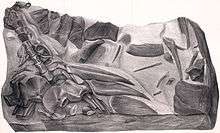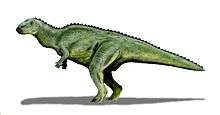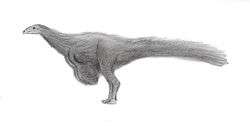Valanginian
| System/ Period |
Series/ Epoch |
Stage/ Age |
Age (Ma) | |
|---|---|---|---|---|
| Paleogene | Paleocene | Danian | younger | |
| Cretaceous | Upper/ Late |
Maastrichtian | 66.0–72.1 | |
| Campanian | 72.1–83.6 | |||
| Santonian | 83.6–86.3 | |||
| Coniacian | 86.3–89.8 | |||
| Turonian | 89.8–93.9 | |||
| Cenomanian | 93.9–100.5 | |||
| Lower/ Early |
Albian | 100.5–~113.0 | ||
| Aptian | ~113.0–~125.0 | |||
| Barremian | ~125.0–~129.4 | |||
| Hauterivian | ~129.4–~132.9 | |||
| Valanginian | ~132.9–~139.8 | |||
| Berriasian | ~139.8–~145.0 | |||
| Jurassic | Upper/ Late |
Tithonian | older | |
| Subdivision of the Cretaceous system according to the IUGS, as of July 2012. | ||||
In the geologic timescale, the Valanginian is an age or stage of the Early or Lower Cretaceous. It spans between 139.8 ± 3.0 Ma and 132.9 ± 2.0 Ma (million years ago). The Valanginian stage succeeds the Berriasian stage of the Lower Cretaceous and precedes the Hauterivian stage of the Lower Cretaceous.[1]
Stratigraphic definitions
The Valanginian was first described and named by Édouard Desor in 1853. It is named after Valangin, a small town north of Neuchâtel in the Jura Mountains of Switzerland.
The base of the Valanginian is at the first appearance of calpionellid species Calpionellites darderi in the stratigraphic column. A global reference section (a GSSP) had in 2009 not yet been appointed.
The top of the Valanginian (the base of the Hauterivian) is at the first appearance of the ammonite genus Acanthodiscus.
Subdivision
The Valanginian is often subdivided in Lower and Upper substages. The Upper substage begins at the first appearance of ammonite species Saynoceras verrucosum and the major marine transgression Va3.
In the Tethys domain, the Valanginian stage contains five ammonite biozones:
- zone of Criosarasinella furcillata
- zone of Neocomites peregrinus
- zone of Saynoceras verrucosum
- zone of Busnardoites campylotoxus
- zone of Tirnovella pertransiens
Palaeontology
†Ankylosaurs
| Ankylosauria of the Valanginian | ||||
|---|---|---|---|---|
| Taxa | Presence | Location | Description | Images |
|
| ||||
Birds (avian theropods)
| Birds of the Valanginian | ||||
|---|---|---|---|---|
| Taxa | Presence | Location | Description | Images |
| France | ||||
Crocodylomorphs
| Crocodylomorphs of the Valanginian | ||||
|---|---|---|---|---|
| Taxa | Presence | Location | Description | Images |
|
| ||||
†Ornithopods
| Ornithopoda of the Valanginian | ||||
|---|---|---|---|---|
| Taxa | Presence | Location | Description | Images |
| Australia | May be a chimera based on multiple species of ornithopods. |
| ||
| Europe | First dinosaur ever found | |||
| Cape Province, South Africa | Generally considered nomen dubium, it classified as a genus similar to Dryosaurus, i.e. an iguanodont. | |||
| Lanzhou, Gansu, China | Notable for its "astonishingly huge teeth", among the largest for any herbivorous creature ever, which indicate it is an iguanodont. The mandible, longer than one meter, suggests very large size for the animal. | |||
| Isle of Wight, England; Niger, Africa | A dryosaurid | |||
†Pterosaurs
| Pterosaurs of the Valanginian | ||||
|---|---|---|---|---|
| Taxa | Presence | Location | Description | Images |
 Lonchodectes (left) | ||||
| Lagarcito Formation, San Luis Province, Argentina; Chile | ||||
†Sauropods
| Sauropods of the Valanginian | ||||
|---|---|---|---|---|
| Taxa | Presence | Location | Description | Images |
†Stegosaurs
| Stegosaurs of the Valanginian | ||||
|---|---|---|---|---|
| Taxa | Presence | Location | Description | Images |
|
| ||||
†Theropods (non-avian)
| Non-Avian Theropods of the Valanginian | ||||
|---|---|---|---|---|
| Taxa | Presence | Location | Description | Images |
|
| ||||
References
Notes
Literature
- Gradstein, F.M.; Ogg, J.G. & Smith, A.G.; (2004): A Geologic Time Scale 2004, Cambridge University Press.
External links
- GeoWhen Database - Valanginian
- Mid-Cretaceous timescale and ühttp://stratigraphy.science.purdue.edu/charts/Timeslices/5_JurCret.pdf Jurassic-Cretaceous timescale], at the website of the subcommission for stratigraphic information of the ICS
- Stratigraphic chart of the Lower Cretaceous, at the website of Norges Network of offshore records of geology and stratigraphy
| Cretaceous Period | |
|---|---|
| Lower/Early Cretaceous | Upper/Late Cretaceous |
| Berriasian | Valanginian | Hauterivian Barremian| Aptian | Albian |
Cenomanian | Turonian | Coniacian Santonian |Campanian | Maastrichtian |






